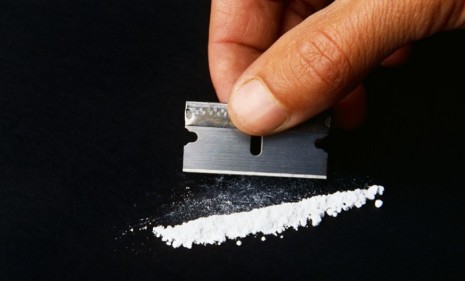America's flesh-eating cocaine problem
Parents have long warned that drugs will fry your brain. Now doctors say cocaine might also rot your skin — literally

It's no secret that cocaine can be dangerous, but drug dealers might be making it more harmful than ever. The U.S. Drug Enforcement Administration recently reported that 82 percent of the cocaine it seizes has been cut with a veterinary drug that can rot away the skin on users' noses, cheeks, and ears. "It's probably quite a big problem," says dermatologist Dr. Noah Craft with the Los Angeles Biomedical Research Insitute. "We just don't know how big." Here, a brief guide:
How does levamisole end up in cocaine?
Drug dealers typically add fillers to cocaine to boost their profits. Cheaper cocaine may be upwards of 90 percent filler. Sometimes, the added powder is just baking soda or some other innocuous substance. But drug cartels in South America increasingly prefer to use levamisole, a veterinary antibiotic normally used to deworm cattle, sheep, and pigs. It's not clear why dealers don't just use baking soda all the time, although studies in rats suggest that levamisole might tingle brain receptors in the same way cocaine does. If that's the case, adding it to the supply might be a way to enhance the effects of cocaine on the cheap.
The Week
Escape your echo chamber. Get the facts behind the news, plus analysis from multiple perspectives.

Sign up for The Week's Free Newsletters
From our morning news briefing to a weekly Good News Newsletter, get the best of The Week delivered directly to your inbox.
From our morning news briefing to a weekly Good News Newsletter, get the best of The Week delivered directly to your inbox.
And the user ends up paying the price?
Yes, in some cases, says Craft, who has published a case study in Journal of the American Academy of Dermatology. Craft linked six patients with patches of dying flesh to tainted cocaine. The wounds typically surface a day after exposure due to an immune reaction that damages blood vessels supplying the skin. Without any blood supply, the skin is starved of oxygen, turns a dark purple, and dies off. While the contamination of the cocaine supply is widespread, not all of those using cocaine experience this adverse reaction. But, anyone who uses cocaine is at risk, Craft says. "Rich or poor, black or white."
Are doctors just discovering this problem?
No, levamisole has been on the radar screen of drug-prevention officials and doctors for a while. In 2009, there were reports of a handful of cocaine users in Canada developing hepatitis C and anemia after using cocaine mixed with levamisole. The killer agent hinders a person's ability to produce white blood cells, which are essential for fighting off sometimes deadly infections. But the DEA's report on the extent of the contamination, explains why some doctors are now seeing gruesome wounds linked to recent cocaine use. "It's important for people to know it's not just in New York and L.A.," says Craft. "It's in the cocaine supply of the entire U.S."
A free daily email with the biggest news stories of the day – and the best features from TheWeek.com
Sources: ABC News, Avvo, Sun Sentinel
-
 How climate change is affecting Christmas
How climate change is affecting ChristmasThe Explainer There may be a slim chance of future white Christmases
-
 The MAGA civil war takes center stage at the Turning Point USA conference
The MAGA civil war takes center stage at the Turning Point USA conferenceIN THE SPOTLIGHT ‘Americafest 2025’ was a who’s who of right-wing heavyweights eager to settle scores and lay claim to the future of MAGA
-
 The 8 best drama movies of 2025
The 8 best drama movies of 2025the week recommends Nuclear war, dictatorship and the summer of 2020 highlight the most important and memorable films of 2025